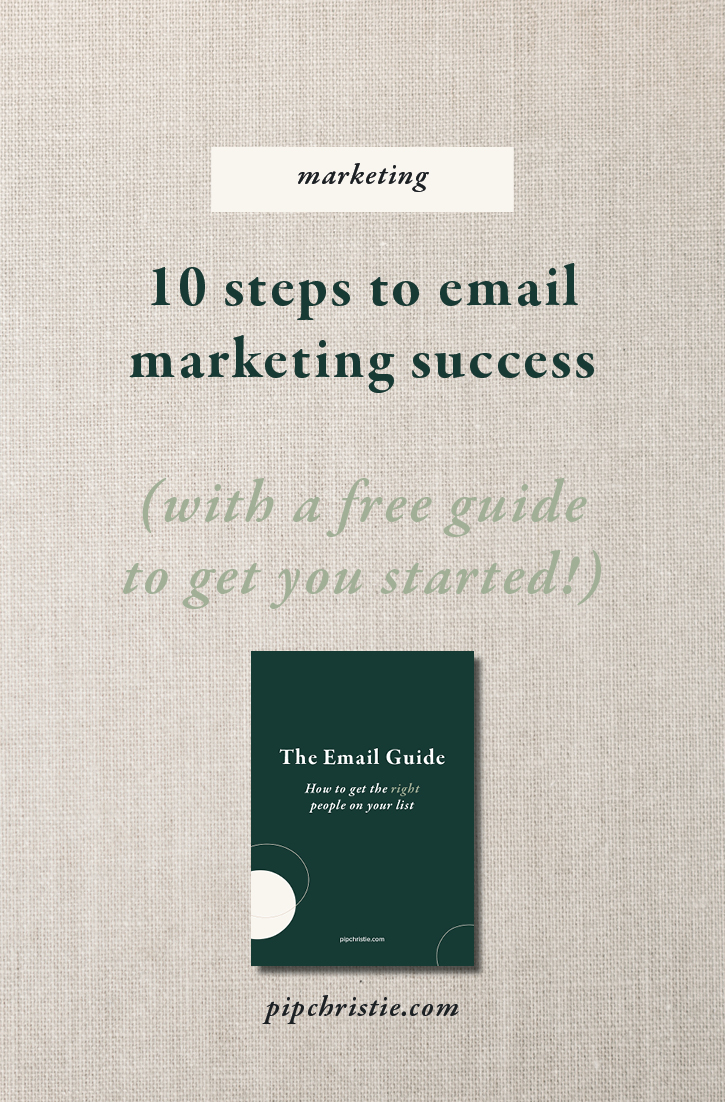10 steps to email marketing success
We all know that email marketing is a key component of any small business’s digital marketing strategy but it can be pretty overwhelming to know where to start, let alone how to get folks to sign up to your mailing list.
I’m pretty sure there isn’t a marketing guru out there who hasn’t sung the praises of email lists at some point. Yet when it comes to actually getting started, advice can often seem contradictory and overly complicated. As with all digital marketing, the best way to kick start your email marketing is to keep it simple. There’s no point dreaming up some fancy pants email automation if you’re not going to have the time to implement it.

Much as I love a smart email marketing campaign, the emails that I open most often are personal newsletters from the small brands and solopreneurs that I love. In fact, I often save them up to read as though I’m diving into a weekly magazine column – they’re that good. Here are ten easy steps to get you started on the path to email marketing success.
1. Be Clear With Your Story
Like any new addition to your marketing strategy it’s vital that you’re clear what your story is from the outset. By this I mean, what makes your business unique? How do you want your customers to feel after connecting with your product or service?
Make sure that you have a clear understanding of the story of your brand before you begin. You need to know who you are before you start communicating that to the world.
2. Find Your Why
There’s no point starting an email list just for the sake of it. If your email list doesn’t have a clear objective then your audience aren’t going to sign up for it.
Now more than ever, a person’s email address is an incredibly precious piece of data so be sure to respect that when promoting your list. Very few people will subscribe just because you tell them to. They want to know what value your emails will bring to them, instead of being just another message filling up their inbox.
Will you be educating your subscribers on new and engaging topics in your industry? Or perhaps you’ll be giving them exclusive access to free resources? Whatever your motivation for email marketing may be, try and offer subscribers something that they won’t find elsewhere through your other channels. That way they’ll be more motivated to sign up and, crucially, stay engaged.
3. Plan Your Content
Now that you know the message you want to communicate and your reason for doing so, it’s time to start planning your email content! First consider how often you want to be sending out your newsletter. Most small businesses opt for a monthly newsletter, simply because it’s more manageable, but if a weekly or fortnightly newsletter sounds good to you then go for it! Just make sure that you’re able to do it consistently.
Once you’ve got your frequency nailed, it’s a good idea to sketch out the next 3-4 months of content and the key topics that you want to focus on in each newsletter. This will help you tie your email marketing in with any campaigns that you’ve got planned whilst also enabling you to stay focussed when times get busy. Even in the most hectic of weeks you can take comfort in the knowledge that your email marketing is already planned out ready for you to start writing.
4. Choose A Provider
When it comes to email marketing the options are endless when it comes to choosing a provider to host your email list and send out your content. Some of the big players include Mailchimp, ConvertKit, Hubspot, Campaign Monitor and Constant Contact. Personally, I recommend Mailchimp.
Why? Well firstly, I use it myself! Secondly, they offer a ‘forever free plan’. This means that your first 2,000 contacts are completely free of charge – giving you access to all the basic tools that you need to design and create a beautiful email newsletter without it costing you a penny. It’s incredibly easy to use and once you pass the 2,000 subscribers mark you will enter an affordable tiered pricing model with even more features to help you make the most of your contacts.
5. Create Your List
So, you’ve chosen your provider. Now it’s time to create that first list! This is actually incredibly simple, all you need to do is hit the ‘create new list’ button in your provider of choice and add a few custom options.
You will need to choose a standard ‘from’ email address that all communications to that list will come from, as well as an address for readers to reply to. It’s a good idea to use an inbox that you check regularly as you don’t want to miss any important messages from potential customers.
You will also need to enter a business address that will be included in the footer of each email for data protection issues. If you don’t have an address that you’re happy to make public e.g. you work from home, then it might be a good idea to set up a P.O. Box to include.
Finally, you will need to customise the unsubscribe forms. Whilst this isn’t an essential step I do recommend it as you want to be giving a professional impression of your business to each and every contact you come across. Even if they’ve chosen to unsubscribe it doesn’t mean that they’ll never buy from you in the future.
6. Create A Welcome Email
Most providers will have an automation feature that enables you to set up a simple welcome email that is automatically sent out to each new subscriber the moment they hit that ‘opt in’ button. Not only is this a great way to reassure them that their subscription did indeed go through but it is also a fantastic way to add value to your subscribers right from the minute they join your list.
How you choose to tailor this email is up to you and your business style but options could include a short message to welcome them to the community, some links to your most popular blog posts or even an exclusive free resource as a thank you gift.
7. Connect Your List To Your Website
Now that you’ve got the back end of your email marketing all ready it’s time for the most important step – sharing it with the world! Most email marketing providers will offer integrations with WordPress and Squarespace, enabling you to seamlessly connect your website and your email marketing. Just navigate to the integrations page on your provider’s platform and follow the directions to set this up.
You may have noticed that I often end my blog posts with an invitation to subscribers to join the Unedited Community but I also feature my newsletter sign up forms across my website, especially on my homepage. This is a great way to invite your audience to engage without it feeling too salesy.
If you’re running a free offer for subscribers then it might be worth adding a subtle slide in bar to promote it. Pop ups are another option but I think we’d all agree that they can often be a bit intrusive for site visitors.
8. Promote Your Newsletter
Once you’ve got your sign up forms ready to go you can start promoting your newsletter. There are so many ways you can do this but what’s important is that you regularly remind your audience that you have a newsletter for them to subscribe to.
Perhaps you run some sponsored posts on social media promoting your free resource offer exclusively for newsletter subscribers. A fantastic free option is to include your newsletter promotion in your content plan for social media, or show your audience on Insta Stories that you’re writing a newsletter to go out later this week and remind them that they don’t want to miss out.
9. Create Your Content
Finally, it’s time for your first newsletter! Whether you’ve got 10s or 1,000s of subscribers on your list, take care to treat them the exact way and remember your why – consider what value you want to be delivering to them.
I really recommend that you write out your content in a separate document before you start designing your newsletter. Unless you’re a very visual business it’s imperative that your content stand out on its own and communicate its value even without a beautiful design. The design work is your opportunity to then take that to the next level.
And remember, always send yourself a test email before you hit send!
10. Review, Review, Review
So you’ve sent out your newsletter. Now what? This is the perfect time to get stuck into the insights of your content. Head on over to your email marketing provider and look through the analytics of your campaign.
Was your open rate quite low? This could be a sign that you need to experiment with some more creative titles, or try sending at a different time of day. Was your click through rate higher than usual? Take a look at what they clicked on and consider how you can incorporate this into future newsletters.
Spending some time looking through the data of each campaign is a great way to gain new insights into your audience and learn what’s resonating with them, and what isn’t. Life is always a work in progress!
So there you have it, 10 simple steps to get you started on the path to email marketing success! I’d love to hear from you, are there any newsletters that particularly resonate with you?
Write your website copy like a pro copywriter (without the pro price tag)
Introducing... the about page roadmap.
You’ll get access to the same copywriting framework I use with my small business clients. So you can have an about page that feels 100% you.



